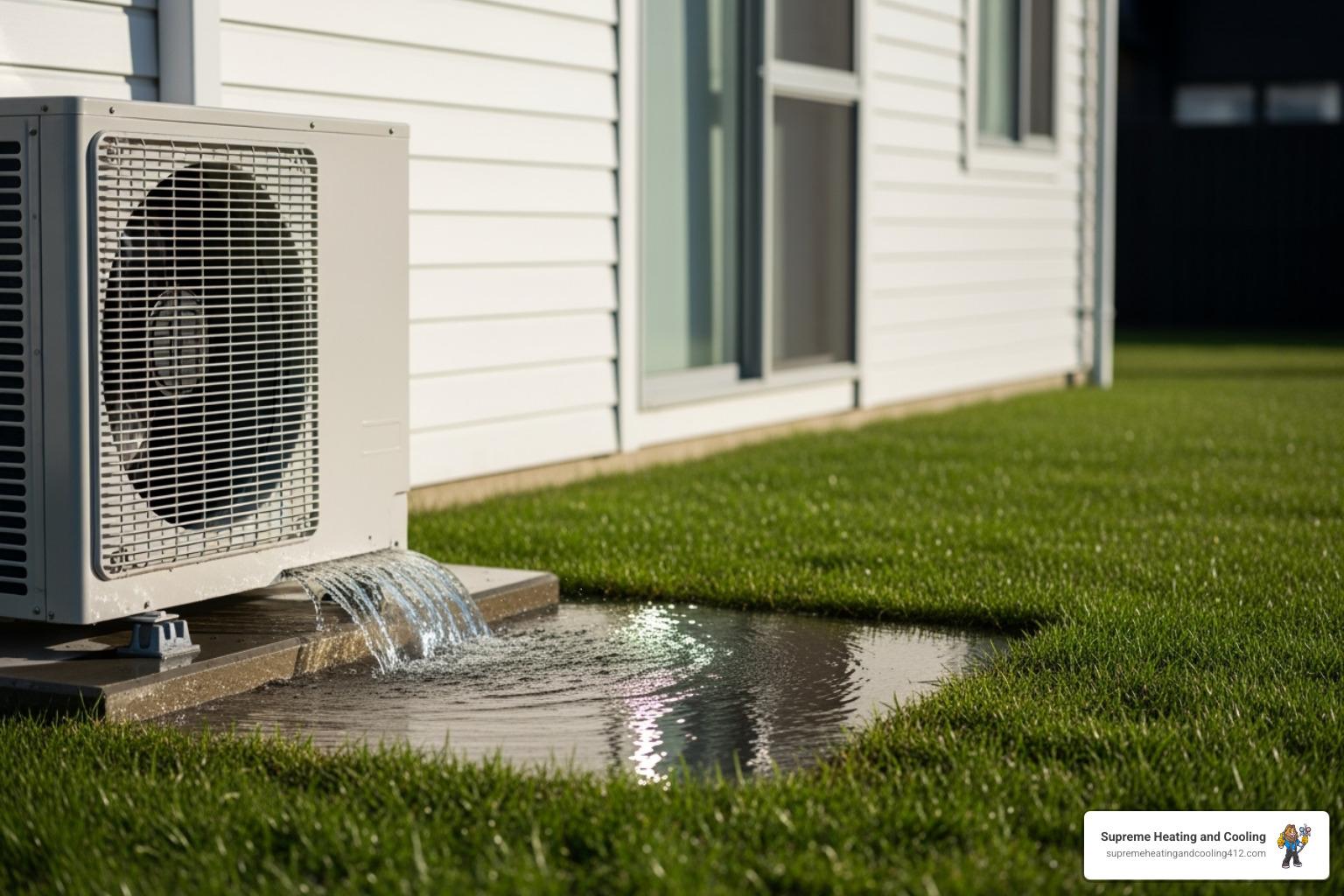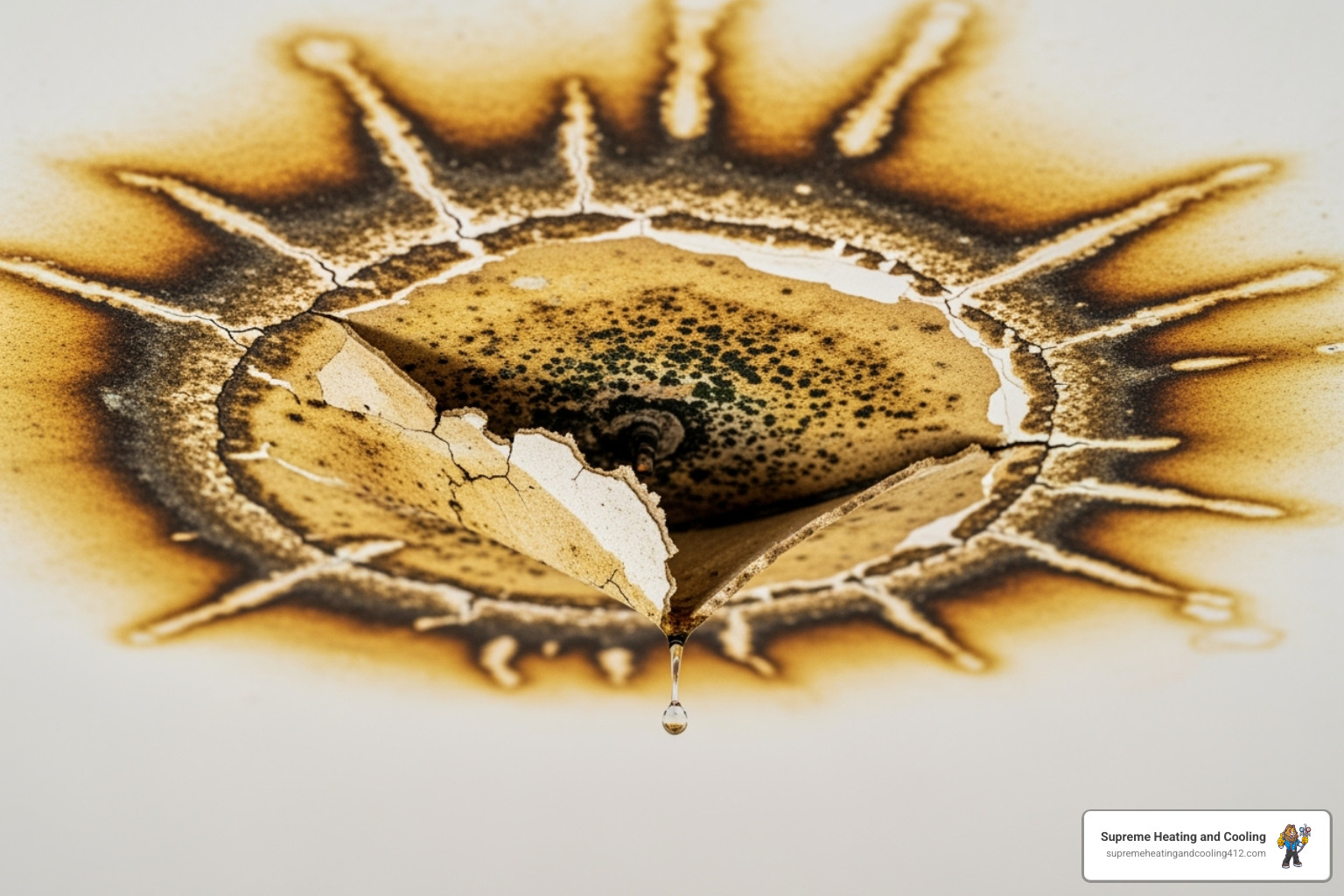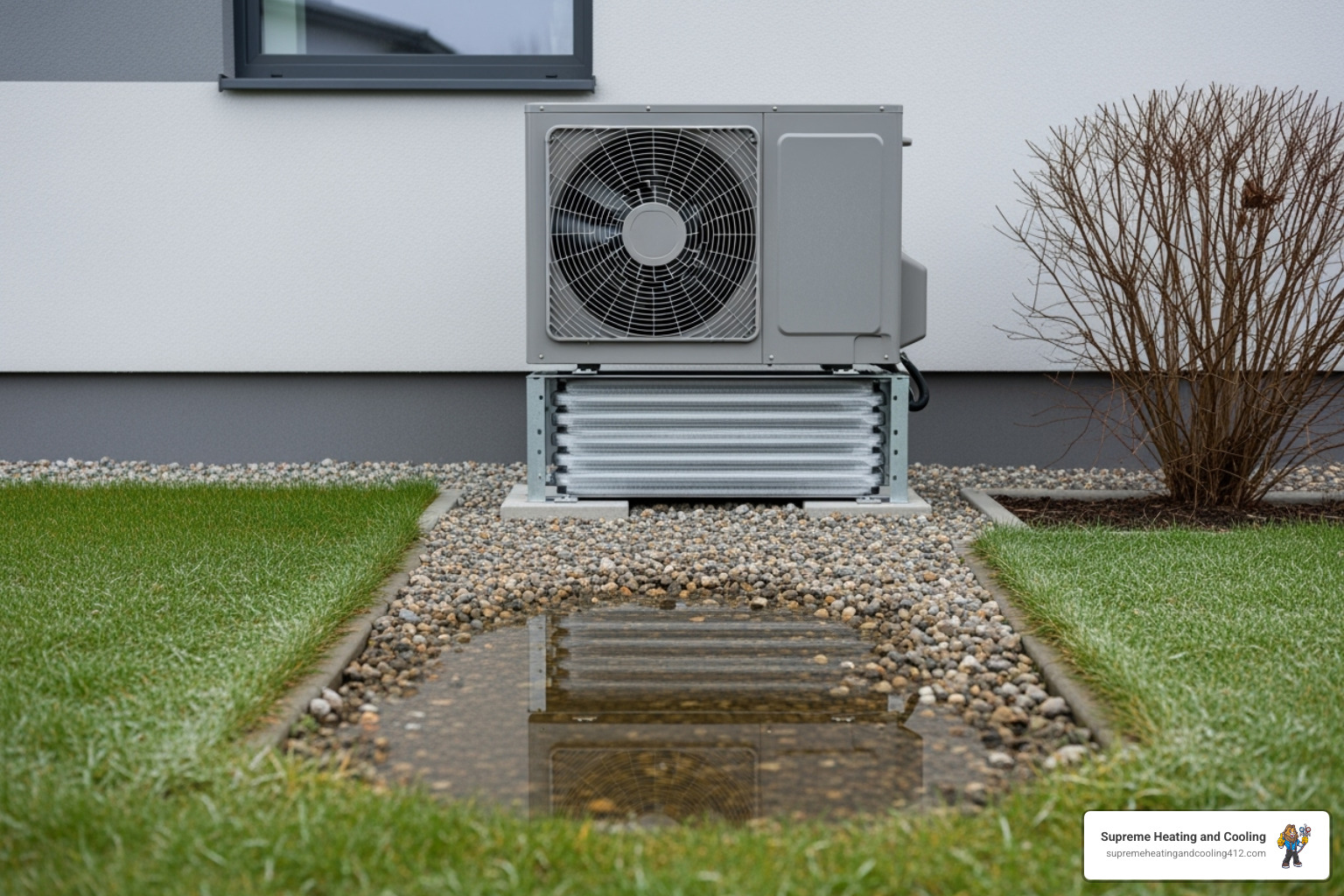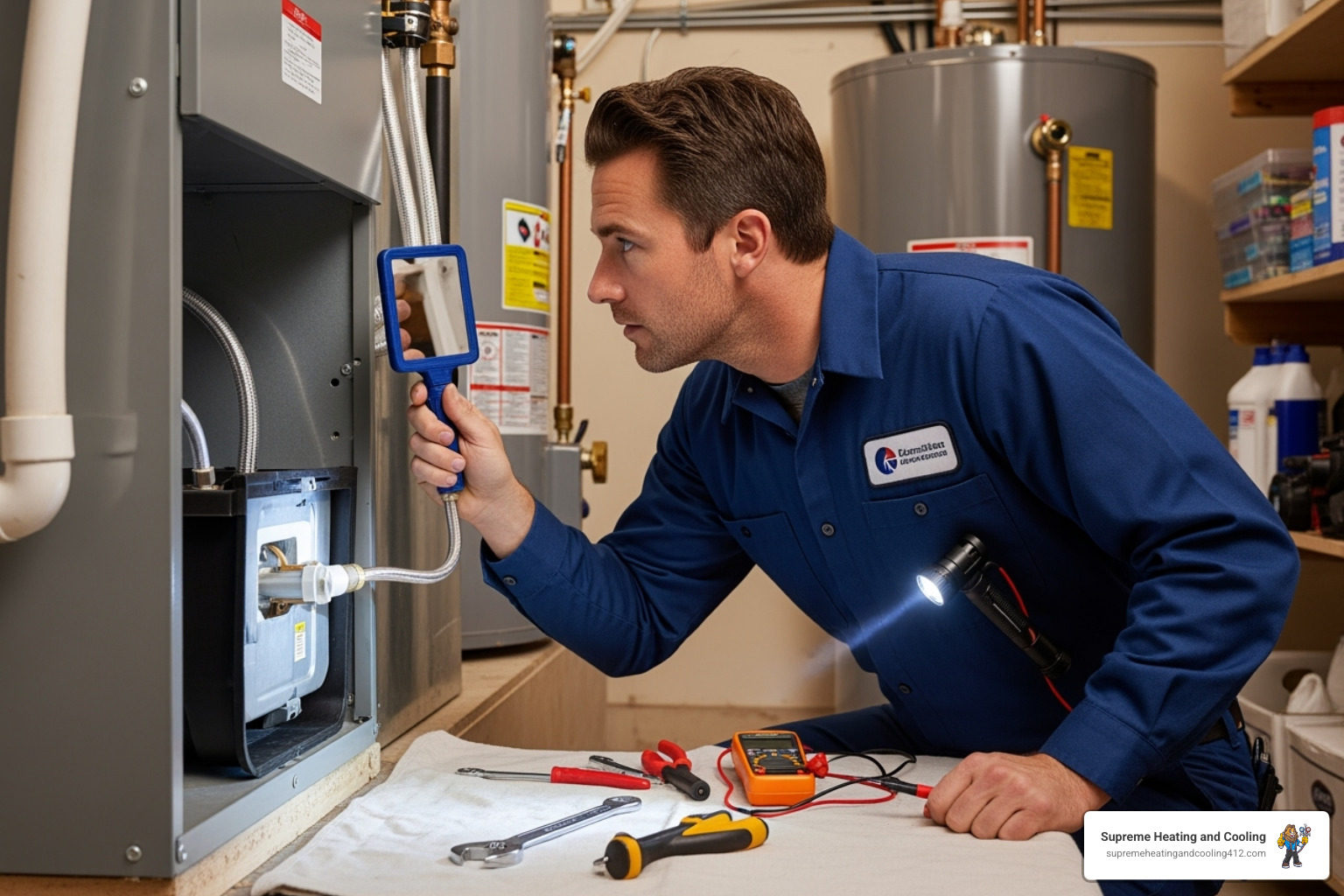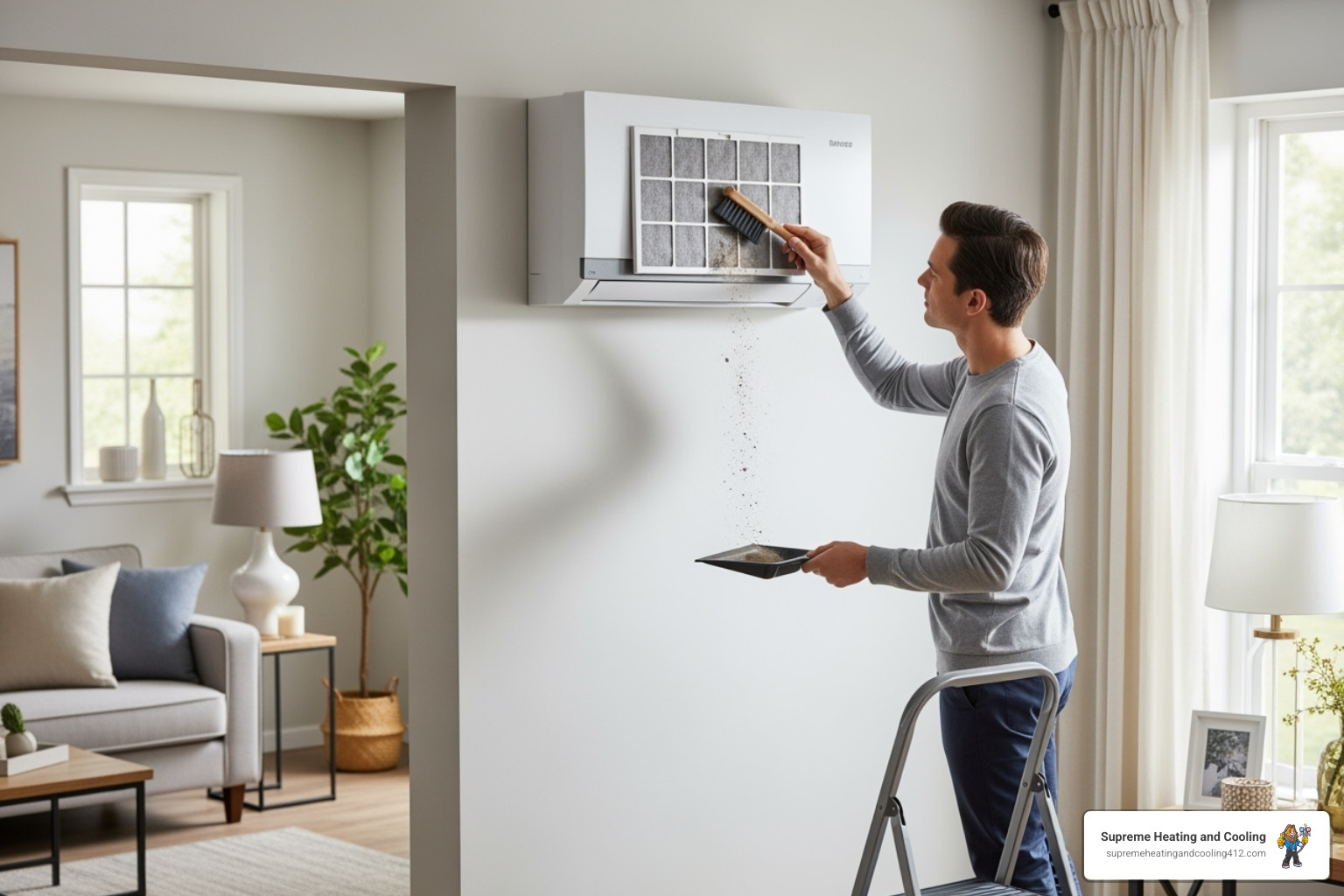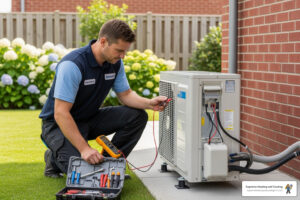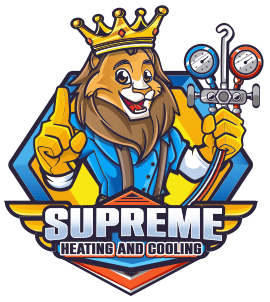When Your Heat Pump Leaks: What Murrysville Homeowners Need to Know
Heat pump leaking water in murrysville, pa is a common concern that can range from normal operation to a sign of serious trouble. Most homeowners panic when they spot water pooling around their system, and for good reason—water damage can ruin floors, ceilings, and walls if left unchecked.
Quick Answer: Is Your Heat Pump Leak Normal or an Emergency?
- Normal: Small puddles outside during winter defrost cycles or humid summer days
- Problem: Water pooling indoors, ceiling stains, musty smells, or ice on coils
- Action needed: Indoor leaks always require professional attention; outdoor leaks may be normal but should be monitored
- Common causes: Clogged condensate drain line, frozen evaporator coil, cracked drain pan, improper installation
If you’re dealing with a heat pump leak in Murrysville, Delmont, Export, or surrounding areas, you need to understand whether it’s part of normal operation or a problem that requires immediate repair. For comprehensive information about heat pump maintenance and services, check out our heat pump services guide. If you need immediate help, contact our Murrysville heat pump repair experts today.
This guide breaks down why heat pumps produce water, how to spot the difference between normal condensation and a serious leak, and what you can do to prevent water damage in your Murrysville home.
Why Heat Pumps Create Water: A Quick Science Lesson
Here’s the thing about heat pumps: they’re basically moisture magnets by design. When you notice water around your system, it’s not necessarily a disaster—it’s often just physics doing its thing.
Your heat pump works by moving heat from one place to another, and this process naturally creates condensation. Think about that ice-cold can of soda sitting on your counter on a muggy day. Water beads up on the outside, right? Your heat pump does the same thing, just on a much bigger scale.
During cooling mode in those sticky Murrysville summers, your indoor unit’s evaporator coil gets really cold. When warm, humid air from your home passes over this chilly coil, the moisture in that air turns into liquid water—just like the soda can. This is actually a good thing! Your system is dehumidifying your home while it cools, which is why the air feels so much more comfortable when your heat pump is running.
But here’s where it gets interesting: your heat pump also produces water during heating mode. When temperatures drop in winter, your outdoor unit extracts heat from the cold outside air (yes, there’s still heat energy even in cold air—pretty cool, right?). As it does this, moisture from the outdoor air can freeze onto the outdoor coil, forming ice.
This is where the defrost cycle comes in. Every so often, your heat pump needs to melt that ice buildup to keep working efficiently. It temporarily reverses operation, sending warm refrigerant to the outdoor coil. The ice melts, drains away, and you’ll see puddles around your outdoor unit. This is completely normal—your system is just taking care of itself.
When everything’s working properly, all this water gets safely channeled away through drain lines and pans. It’s designed to handle the moisture without causing problems in your home.
Indoor Unit vs. Outdoor Unit Condensation
Where you see water—and when—tells you a lot about whether your heat pump leaking water in murrysville, pa situation is normal or needs attention.
Your indoor air handler is the condensation champion during summer. In Murrysville’s humid climate, this unit can produce quite a bit of water as it pulls moisture from your home’s air. All that water should collect in a drain pan and flow out through a condensate drain line to the outside or a drain. You shouldn’t see any of this water—it should all disappear quietly behind the scenes.
The outdoor condenser unit, on the other hand, is where you’ll see water during winter operation. When it’s cold outside and your heat pump is in heating mode, that outdoor coil collects frost and ice. During defrost cycles, you’ll see water pooling underneath the unit or dripping from it. You might also notice some condensation around the outdoor unit on particularly humid summer days, even when it’s cooling your home.
Murrysville’s weather keeps your heat pump busy year-round. Those hot, humid summers mean lots of indoor condensation. Cold winters mean regular defrost cycles and outdoor water. Understanding which unit should be producing water—and when—helps you spot the difference between normal operation and a real problem that needs fixing.
Is it a Drip or a Disaster? Spotting the Signs of a Problematic Leak
So you’ve spotted water near your heat pump. Now comes the million-dollar question: is this normal condensation doing its job, or is something wrong? The good news is that your system will usually give you clear signals when there’s a problem. Let’s walk through what to watch for.
When you see water stains creeping across your ceiling or down your walls, especially if your indoor unit lives in an attic or utility closet, that’s your heat pump waving a red flag. This means water isn’t draining where it should—it’s escaping into your home’s structure instead. Similarly, if you notice puddles forming around the base of your indoor air handler, that’s not part of the plan. Water should be quietly whisking away through the drain line, not pooling on your floor.
Your nose can be just as important as your eyes here. A persistent musty or moldy smell coming from your vents or lingering around your unit tells you that moisture has been hanging around too long in places it shouldn’t be. This hidden dampness creates the perfect environment for mold and mildew to thrive, which is both a health concern and a sign that water is escaping somewhere in your system.
Ice forming on your indoor evaporator coil or refrigerant lines is another serious warning sign. Yes, you might see some frost on your outdoor unit during winter—that’s expected. But ice on your indoor components? That’s trouble. When that ice eventually melts (and it will), it creates a sudden flood of water that can overwhelm your drain pan and spill into your home.
Finally, if your system keeps shutting itself down unexpectedly, it might actually be trying to protect you. Many heat pumps have a safety switch in the drain pan that trips when water levels get too high. It’s like your system saying, “I’ve got too much water here, and I’m not going to keep running until someone fixes this.”
Troubleshooting a heat pump leaking water in Murrysville, PA: Indoor Leaks
Here’s a rule that’s easy to remember: any water leak from your indoor unit is always a problem. There’s no “maybe” or “wait and see” when it comes to indoor leaks. Unlike outdoor puddles that might be perfectly normal, water inside your home from your heat pump always means something has gone wrong.
Why are we so emphatic about this? Because the potential for damage is significant and happens fast. Water can warp your beautiful hardwood floors, turn drywall into mush, and compromise wooden beams and joists. Even worse, it creates the perfect breeding ground for mold that can hide in walls and ductwork, leading to health problems and expensive remediation down the road. And let’s not forget the very real danger of water mixing with electrical components—that’s a recipe for short circuits or worse.
So what’s causing the leak? Most often, you’re dealing with one of three culprits. A cracked drain pan sits under your evaporator coil catching all that condensation we talked about earlier. Over time, this pan can crack from age, rust through from constant water exposure, or even arrive with manufacturing defects. When it fails, water simply drips right through.
The second usual suspect is a clogged condensate drain line. This pipe is supposed to carry water safely away from your unit, but it’s essentially a dark, damp tube—perfect for growing a slimy cocktail of algae, mold, dirt, and debris. When this gunk blocks the line, water backs up and overflows the pan. This is actually the most common cause of heat pump leaking water in Murrysville, PA situations we see.
The third issue is a frozen evaporator coil. When your indoor coil freezes up—usually because of restricted airflow from a dirty filter or low refrigerant levels—it eventually thaws. That sudden melting creates more water than your drain pan was designed to handle, and the overflow spills into your home. Proper use and regular maintenance can prevent many of these freezing issues before they start.
Outdoor Leaks: What’s Normal for Murrysville Weather
Now let’s talk about water around your outdoor unit, where the story is quite different. Most of the time, outdoor puddles are completely normal and nothing to worry about.
During Murrysville’s cold winter months, you’ll regularly see puddles forming during your heat pump’s defrost cycle. Your outdoor unit needs to melt ice off its coils to keep working efficiently. These defrost cycles typically run for 5 to 10 minutes and might happen every 30 to 90 minutes when it’s really cold outside. The melted ice has to go somewhere, so it drips down and creates a puddle underneath. This is exactly what should happen.
Even in summer, on those sticky, humid days that Murrysville knows so well, you might notice some drips from your outdoor unit. As it works to move heat and humidity out of your home, a little condensation on the outside is perfectly normal.
But there are times when outdoor water should raise your eyebrows. If you’re seeing persistent leaks that don’t seem connected to defrost cycles or humid weather, or if your heat pump isn’t heating or cooling your home properly, something’s not right. Similarly, while a little frost is expected, excessive ice buildup—like your outdoor unit looking like it’s encased in a block of ice—indicates a problem with your defrost system or another underlying issue. This kind of ice accumulation will hurt your system’s efficiency and could lead to damage if left unchecked.
Common Culprits Behind a Heat Pump Leaking Water in Murrysville, PA
Now that we know the difference between a normal drip and a disaster, let’s dive into the most common reasons why your heat pump might be springing a leak. Understanding these causes is the first step toward effective prevention and repair.
After years of diagnosing heat pump leaking water in Murrysville, PA issues, we’ve seen the same culprits show up time and time again. Whether you have a traditional ducted system or a ductless mini-split, the root causes of water leaks are surprisingly consistent. The encouraging news? Most of these problems are completely preventable with a little regular care.
The #1 Cause: A Clogged Condensate Drain Line
If we had to pick the single most common reason for indoor heat pump leaks, the condensate drain line would win by a landslide. This unassuming pipe has one straightforward job: carry away all the water that drips off your evaporator coil and get it safely out of your house. It’s a simple task, but it’s also where things go wrong most often.
Think about what’s happening inside that drain line. It’s dark, damp, and filled with water—basically a vacation resort for algae and mold. Add in the dust and debris that naturally circulates through your home’s air, and you’ve got a recipe for a slimy, stubborn clog. This gunk builds up gradually, starting as a thin film and eventually forming a blockage that stops water from flowing through.
When the drain line gets clogged, you’ll usually know it pretty quickly. Water starts backing up and overflowing from the drain pan beneath your indoor unit. You might spot puddles forming around the base of your air handler, or notice water stains spreading across your ceiling if the unit is in your attic. Many modern systems have a safety float switch that detects rising water levels and shuts down the entire system to prevent flooding—so if your heat pump keeps turning itself off, a clogged drain line might be the culprit.
The Deep Freeze: How a Frozen Evaporator Coil Causes Floods
Your evaporator coil is supposed to be cold—that’s how it pulls heat and humidity from your air. But there’s a big difference between “properly cold” and “frozen solid.” When something goes wrong and your coil turns into a block of ice, you’re setting yourself up for a watery mess.
Here’s what happens: the ice keeps building up on the coil until eventually, something changes. Maybe the system cycles off, maybe temperatures rise, or maybe the ice just reaches a tipping point. Either way, all that frozen water starts to melt. And when it does, it creates far more water than your drain pan was designed to handle. The result? A flood that spills over onto your floor, into your ceiling, or wherever else gravity takes it.
So what causes the coil to freeze in the first place? Restricted airflow is usually the main villain. When air can’t move freely over the coil, the refrigerant inside gets too cold and freezes the moisture in the air on contact. The most common reason for restricted airflow is embarrassingly simple: a dirty air filter. That’s why we’re always harping on about changing your filters regularly—it’s not just about air quality, it’s about preventing leaks and system damage.
The other major cause is low refrigerant levels. If your system is low on refrigerant due to a leak, it can’t absorb heat properly, causing temperatures to plummet and ice to form. While a refrigerant leak isn’t technically a water leak, it directly leads to coil freezing and the subsequent flooding when everything thaws out.
This is where proper use and regular maintenance really prove their worth. A well-maintained heat pump with clean filters and proper refrigerant levels shouldn’t develop frozen coils.
Other Potential Problems: Cracked Drain Pan & Faulty Installation
While clogged lines and frozen coils cause the majority of leaks, a couple of other issues deserve attention.
Your drain pan sits beneath the evaporator coil, catching condensation day in and day out. Most pans are made from plastic or metal, and after years of constant exposure to water, they can start to show their age. Metal pans might corrode and develop rust holes, while plastic pans can become brittle and crack. Sometimes the damage is obvious—a visible crack or hole. Other times, it’s a hairline fracture that you can barely see but that’s more than big enough to let water escape.
Then there’s the issue of improper installation. This one’s frustrating because it means the problem existed from day one. If your indoor unit isn’t perfectly level, water won’t flow correctly into the drain pan or down the drain line—it might pool in the wrong spots or drain too slowly. Similarly, if the drain pipes weren’t connected properly or don’t have enough downward slope, water can back up and overflow. We’ve seen drain lines that actually slope upward in places, forcing water to fight gravity just to drain. That never ends well.
This is exactly why choosing an experienced, detail-oriented HVAC contractor matters so much. A quality installation prevents problems before they start, while a rushed or careless job can leave you dealing with leaks for years to come.
Your Proactive Plan: Prevention and Professional Repairs
Here’s the truth about heat pump leaking water in Murrysville, PA: most problems don’t just appear out of nowhere. They develop slowly over time, giving you plenty of opportunity to catch them before they turn into expensive headaches. The best defense against water damage, surprise repair bills, and uncomfortable nights is a solid offense—regular maintenance and knowing when to call in the experts.
Think of it this way: your heat pump works hard for you every single day, moving heat in and out of your home through every season Murrysville throws at it. A little attention and care goes a long way toward keeping it running smoothly, efficiently, and most importantly, leak-free. We’ve seen countless situations where a simple maintenance task could have prevented thousands of dollars in water damage repairs.
Preventing a heat pump leaking water in Murrysville, PA
The good news? You don’t need to be an HVAC expert to protect your home from most heat pump leaks. A few simple habits can make all the difference.
Start with your air filters. This is the single most impactful thing you can do as a homeowner. Change them every 30 to 90 days, depending on how much dust, pet hair, and activity your home sees. A clean filter means proper airflow, which prevents that evaporator coil from freezing up and flooding your space when it melts. Set a reminder on your phone—it’s that important.
Give your outdoor unit some breathing room. Take a walk outside every few weeks and check on your condenser. Rake away fallen leaves, pull any weeds that have crept up, and trim back bushes or shrubs to at least two feet away from the unit. Your heat pump needs good airflow to work efficiently and avoid ice buildup that can lead to leaks.
Keep an eye on your drain system. Every month or so, take a quick peek at your indoor unit. Look at the drain pan—is there standing water that shouldn’t be there? Check the condensate drain line for any obvious kinks or blockages. These visual inspections take just a minute but can alert you to problems before they become serious.
Try the vinegar trick. About four times a year, pour a cup of distilled white vinegar down your condensate drain line (if you can access the cleanout port). This simple step helps prevent that slimy buildup of algae and mold that causes most drain line clogs. Skip the bleach—it can corrode pipes over time and cause more problems than it solves.
When to Call a Professional for Your Heat Pump Leak
While DIY maintenance is wonderful, some situations are beyond what you should tackle yourself. Knowing when to pick up the phone can save you time, money, and stress—not to mention prevent a small issue from becoming a major disaster.
If you see significant water pooling indoors, turn off your system right away and give us a call. This isn’t a “wait and see” situation. Large amounts of water accumulating rapidly means something has failed, and every minute counts when it comes to preventing damage to your floors, walls, and ceilings.
Ice where it shouldn’t be is always a red flag. Whether it’s on your indoor evaporator coil or coating the refrigerant lines, visible ice means your system isn’t working correctly. Shut it down and let us figure out what’s causing it—whether it’s restricted airflow, low refrigerant, or another issue that needs professional diagnosis.
Suspected refrigerant leak? Call immediately. This isn’t something to DIY. Refrigerant requires specialized equipment and certification to handle safely. If you hear hissing sounds, notice ice forming on lines, or see your system’s performance dropping, let our trained technicians take care of it properly.
When your system acts erratically, like cycling on and off frequently or refusing to start altogether, there’s usually more going on than meets the eye. These performance issues often connect to leaks or underlying problems that need professional troubleshooting to resolve correctly.
Electrical problems demand immediate attention. If you notice flickering lights when your heat pump runs, smell anything burning, or have circuit breakers tripping, turn off power to the unit at the breaker box and call us right away. Water and electricity are a dangerous combination that requires professional handling.
At Supreme Heating and Cooling, we’ve seen just about every heat pump leak situation imaginable in Murrysville homes. Our team knows exactly what to look for, how to diagnose problems quickly, and how to fix them right the first time. We’re not here to upsell you on services you don’t need—we’re here to keep your home comfortable and safe with honest, straightforward service.
Your Local Solution for Heat Pump Leaks in Murrysville
We’ve covered a lot of ground today, and if there’s one thing we want you to remember, it’s this: a heat pump leaking water in Murrysville, PA should never be ignored. What might seem like a minor inconvenience—a small puddle here, a damp spot there—can quickly escalate into something much more serious. Water damage doesn’t wait around. It seeps into your floors, creeps up your walls, invites mold to set up shop, and before you know it, you’re facing repairs that could have been easily avoided with prompt attention.
The good news? You now know the difference between normal condensation and a genuine problem. You understand that those puddles outside during a winter defrost cycle are just your heat pump doing its job, while any water pooling around your indoor unit is a red flag waving for help. You’ve learned about the most common culprits—clogged condensate drain lines that get gunked up with algae and debris, frozen evaporator coils that melt and flood your drain pan, cracked drain pans worn down by time, and even faulty installation that sets you up for problems from day one.
More importantly, you’re equipped with practical steps to keep your system healthy. Changing those air filters regularly, keeping your outdoor unit clear, and doing a quarterly vinegar flush can go a long way in preventing leaks before they start. But we also know that some issues are beyond the DIY field, and that’s exactly where we come in.
At Supreme Heating and Cooling, we’re not just another HVAC company serving Murrysville—we’re your neighbors. We understand the humid summers and cold winters that put extra demands on your heat pump. We know you want honest answers, not high-pressure sales tactics. Our team is built on trust, competitive pricing, and treating every home like it’s our own. When you call us, you’ll talk to real people who genuinely care about solving your problem, not upselling you on things you don’t need.
If you’re dealing with a leak right now, or if you just want peace of mind with a professional inspection and tune-up, we’re ready to help. Don’t let a small drip become a major disaster. Contact us for expert heat pump services in Murrysville, PA and let us take care of your home the way it deserves. We’re here to keep you comfortable and dry, all year long.

